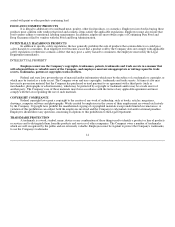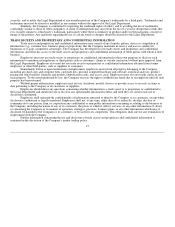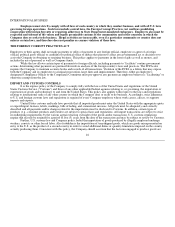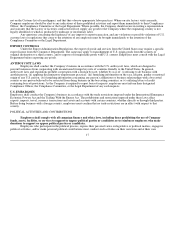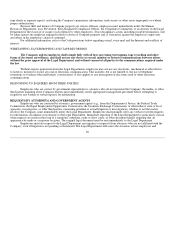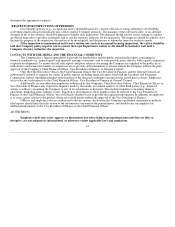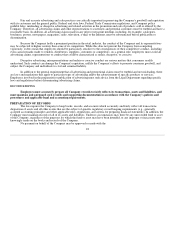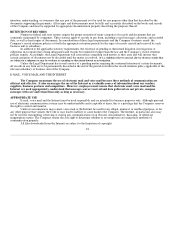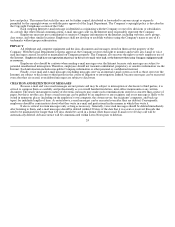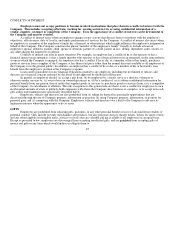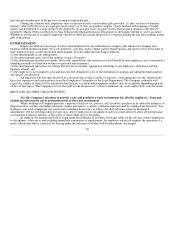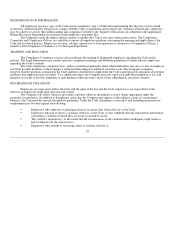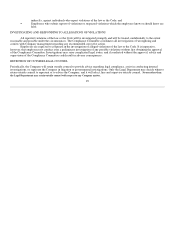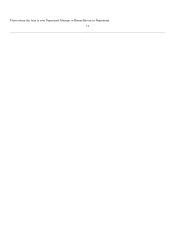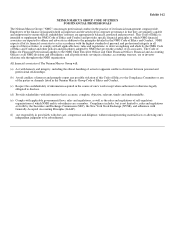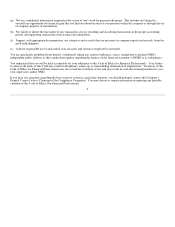Neiman Marcus 2002 Annual Report Download - page 161
Download and view the complete annual report
Please find page 161 of the 2002 Neiman Marcus annual report below. You can navigate through the pages in the report by either clicking on the pages listed below, or by using the keyword search tool below to find specific information within the annual report.
laws and policy. This means that such files may not be further copied, distributed or forwarded to anyone except as expressly
permitted by the copyright owner or with the prior approval of the Legal Department. The Company's copyright policy is described in
the Copyright Compliance section of the Code.
Each outgoing Internet e-mail message is identified as originating with the Company or one of its divisions or subsidiaries.
As a result, like other official communications, e-mail messages sent via the Internet must responsibly represent the Company.
Employees must not post confidential or sensitive Company information on the Internet, including websites, news groups,
chat rooms, and other similar locations. Employees shall not develop or establish websites using the Company's name or any of it's
trademarks without proper authorization.
PRIVACY
All telephone and computer equipment and the data, documents and messages stored on them are the property of the
Company. With the Legal Department's express approval, the Company reserves the right to monitor and review any e-mail or voice
mail messages created, received or maintained on Company property. The Company also reserves the right to review employee use of
the Internet. Employees shall have no expectation of privacy in the use of e-mail, voice mail, or the Internet when using Company equipment and/
or resources.
Employees also should be cautious when sending e-mail messages over the Internet because such messages are subject to
potential unauthorized interception. Therefore, employees should not transmit confidential, proprietary or sensitive information via the
Internet. Such information includes non-public Company information or other personal or confidential material.
Finally, voice mail and e-mail messages (including messages sent via an internal e-mail system as well as those sent over the
Internet) are subject to disclosure to third parties in the course of litigation or investigation. Indeed, because messages can be recreated
even after they are erased, even deleted messages are subject to disclosure.
CREATION AND RETENTION OF MESSAGES
Because e-mail and voice mail messages are not private and may be subject to interception or disclosure to third parties, it is
critical to compose them as carefully and professionally as you would handwritten letters, inter-office memoranda or any written
document. The nearly instantaneous nature of electronic messages may make such communications seem less concrete than a piece of
paper, but this is not the case. Every e-mail message can be printed by an employee or any recipient, and every message is likely to be
stored in numerous places (including on the employee's own computer, the system server, the recipients' computers, and back up
tapes) for indefinite lengths of time. As noted above, e-mail messages can be recreated even after they are deleted. Consequently,
employees should be conscientious about what they write in e-mail and professional in the manner in which they write it.
It also is critical to retain messages only as long as necessary. Generally, voice mail messages should be deleted immediately
after listening to them, and e-mail messages should be deleted within 120 days of the date that it was sent or received. Records that
need to be maintained for longer than 120 days should be saved in a format other than e-mail. E-mail over 120 days old will be
automatically deleted. Advance notice will be communicated within Lotus Notes prior to deletion.
24


